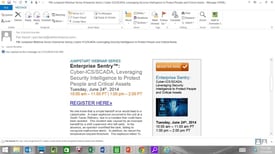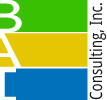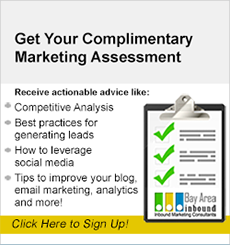It can be a tremendous amount of work to do a weekly demo webinar series, I've done them many times, so I definitely know. The upside is, once you put them in place, you are done and they continue to drive revenue effectively for 3 months or 2 years if you are Palo Alto Networks and keep the same webinar series running for that long.
What You Will Need to Create Your Webinar Series
- a seperate landing page and workflow behind each date offered on the initial two-tiered landing page
- a product manager to demo the product each week and answer live questions at the end
- a way to "can" the data of a real-world customer or a live demonstration of your product in action
- go-to-webinar software to host your webinar and take care of calendaring issues
- marketing automation software to create the emails with offers, landing pages with forms for prospects to sign up, send reminders, and send follow up surveys and offers
As much work as they are, product demo webinar series are also a very, very effective educational offer that brings prospects a lot closer to closing in a sale. Below I tell you why and give you tips on how to do them.
Nuts and Bolts of Creating the Webinar Series
Graphic of the top-tier landing page required for a weekly webinar series. You will need to create a landing page with a form, a thank you page, and workflow for each of the 4 webinars in the series, then clone them for every date and hyperlink them to the top-level landing page dates. You will also need to create 4 different emails as shown below, describing real-world pain points your customers have that your solution addresses, then clone them and change the dates for each webinar as well before you blast. I recommend blasting every week for 4 weeks then take a month off. Then start again. You will have attendees at all 4 webinars this way as people schedule out in advance to coincide with their availability. You don't want to blast too often or your unsubscribe rates go up.
 |
eBooks Are a Lot Easier to Create, So Why Bother with a Demo Webinar Series?
I remember reading the statistic a few years ago on Hubspot's blog, "eBooks get six times the downloads as webinars." Of course, it is easy for Hubspot to gleen these types of statistics because somewhere north of 13,000 companies run campaigns on their SaaS Marketing Automation Software.
Now that I've done a lot of campaigns for a lot of different companies, I can absolutely corroborate those numbers. I also can attest to the fact that eBooks are a lot less work, but no matter how well written, an eBook still won't demonstrate the technical feasibility as concretely as a live working demo of your product will.
Technical feasibility is one of the important questions in the middle-of-the funnel for prospects. They want to make sure your product will work well to solve their pain point, they want it to run in their environment without messing anything up. A live demo is a good step towards building their confidence that your product will do both.
Can't We Just Do Individual Demos to Avoid All the Work of a Demo Webinar Series?
Yes, salespeople can demo the product individually, but a lot of people don't want to engage with a salesperson until they are 85% of the way down the funnel. In today's world of self-educated shoppers who google to find what they need, when they need it, B2B shoppers like the anonymity of being able to see the product in action, without getting entangled with a salesperson.
Don't get me wrong, there's no one more engaging than a good salesperson, but when you get 200 of them calling you six times each, it can overwhelm your work and your life. It is a self-preservation mechanism that we have developed to avoid salespeople until we know we are interested, just like why we use spam filters, and caller ID to filter the 6,000 messages companies want us to hear about their products and services every day.
Prospects like the anonymity of being part of a group and they like to see other people's live questions at the end of the webinar.
And yes, you will get far less people signing up for the webinar demo series, but those people are much farther down the sales funnel than someone who downloads an eBook. For one thing, it is a much higher commitment in time to attend a demo webinar. A demo of the product indicates a real need and a real readiness to address that need, as opposed to a webinar where you have a guest speaker that is an expert, which may mean the attendees are interested in the standards body or market trend but have not zeroed in on your product as a serious contender to solve their problem.
I Thought a Webinar Was a Good Top-of-the-Funnel Offer?
A webinar that offers a well-known guest speaker is a good top of the funnel offer to draw people in to learn about your product or brand as a piggy back to an industry trend or standard body expert. A weekly demo webinar is a middle-of the funnel offer. It answers the questions the customer has about technical feasibility of your product in their environment. It gets them up to speed on the interface and how it will work.
When they see a working demo, they see exactly what they will get and how it is working for another customer. If they like what they see your product can do, you are a big step closer to a sale. Prospects that attend demo webinars typically have a very high close ratio. They still need to be convinced of ROI, that you are the best solution in the market (competitive analysis). But often a good demo will show them how your solution is the best because it demonstrates the time saved and problems solved in a concrete way. You still need to do offers that address other middle-of-the funnel questions.
It Seems Like Customers are Bored with Our Product Demo Webinars
I've heard this before and we turned it around by focusing the demo webinars on real-world incidents. For example, a security company is demonstrating all the bells and whistles their massive and impressive software can do to protect companies with infrastracture like oil refineries, utilities, airports, and even military bases, but they say that prospects seem to check out and not be interested in the demo.
To get rid of the boring factor, at Alert Enterprise, a security company whose enterprise software protects both Operational Technology (OT) converged with Information Technology (IT), we chose some well-known security incidents and researched how each incident unfolded. So instead of boring people to tears with every bell and whistle the software can do, we gave them the well-known scenarios such as the Navy Yard Shooting Incident, the Runaway Lac Megantiac Train Incident, the Chevron Oil Refinery Explosion and we walk them through how the software could have stopped or mitigated each phase of the incidents to protect people's lives as well as company infrastructure.
We chose incidents from 3 different verticals for each weekly event to demonstrate the versatility of the product, so attendees can imagine their vertical security and safety needs being met with the product as well. Each time we blasted email inviting prospects to attend we outlined a few details of each incident and said we would show how to stop them in order to drive attendance.
Examples of Other Successful Weekly Demo Webinar Series
At Imanami, an Active Directory Group Management Software company, who has 4 different software products, we demonstrated one product each week in a round robin fashion with real-world IT Management issues to demonstrate how the software solves the prospects real-world problems such as 25 new employees join the company and IT doesn't need to do anything to add them to the right printers or give them file access because "Synchronize" uses role-based rules using geography and title to assign them to proper resources.
At Palo Alto Networks, an IT Security company, we used a canned demonstration of the IT software on a University campus because that is a challenging environment, with thousands of users joining and leaving the wifi network on campus each semester. It is also a particularly big IT security risk because students participate in every kind of social media and they use every method of file sharing as well. The canned presentation was in a loop, but product managers could still dive into different features of the next-gen firewall while running on that loop, directed by the interests of the webinar attendees.
e question and answers at the end of each session are are always different each week. For Q&A, we used the "type-your-question-in" method so we could prepare answers and pick and choose and queue them up in a way they were most beneficial for the listeners.
Can't I Just Do the Demos Monthly Instead of Weekly?
Well, you can do nothing and not grow your business at all, ha. To be honest, a lot of people's gutt reaction to all the work of creating a weekly demo webinar series is, "can't we just do it monthly?" They often worry they won't get enough attendees if they do it weekly and it will be embarrassing. This is the exact opposite of how it works.
People will attend the webinar series can be prospects, competitors, your own employees, or even employees at companies who have already purchased your product. The weekly webinar series demonstrates a lot of interest since you are running weekly webinars.
Companies make the mistake of thinking there won't be enough interest in the webinar series, so they decide to do one every 2 weeks, or every month instead. This is a mistake and a self-fulfilling prophecy. It is harder for prospects to attend if you don't run them every week because people have busy work lives and also demonstrates that you feel their won't be enough interest to run one every week. If you subliminably tell people there isn't a lot of intest in your product, why should they bother?
There you have it, details of how to do one of the most effective and labor-intensive offers I create for companies, but also one of the best middle-of-the-sales-funnel offers to get sales flowing. So remember to do your eBooks to bring in leads, but also do your demo webinar series to get them to close in business.
Bay Area Inbound is a demand generation marketing consulting company in the SF Bay Area that specializes in creating educational offers for technology companies of all sizes. Contact: Laurie at 510-543-7593 or Laurie@BayAreaInbound.com. Follow us at www.bayareainbound.com/blog.
For a free digital marketing evaluation and recommendations, sign up by clicking the button below:

